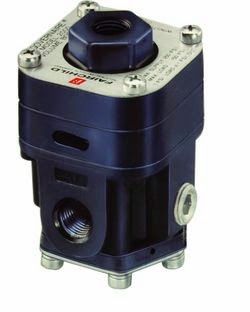 |
| Electronic pressure controller provides closed loop PID control of outlet pressure. Image courtesy of Rotork Instruments - Fairchild |
Rotork Instruments, as part of their Fairchild brand, offers a series of electro-pneumatic pressure controllers that have built in PID closed loop microprocessor control utilizing a remote analog or digital setpoint signal. The electronic controller regulates feed and bleed solenoid valves to control pressure in the signal chamber of the booster section. Outlet pressure is measured and used as a feedback signal to the controller to provide accurate control of the outlet pressure. The device functions as a volume booster and I/P transducer.
Any of the devices can be controlled from the onboard keypad or a remote signal. A remote pressure sensor line can also be used with the controller to derive the feedback signal from further downstream from the instrument. This is helpful in eliminating pressure drop effects over the distance from the controller to an identified process point. The remote sensing also can improve system response. Adding the remote sensing is simple, just remove the factory installed plug and install an adapter that facilitates a line connection.
The various models are available with volume booster sections rated for 1 to 700 SCFM. More detail is found in the specification sheet provided below. Share your pressure control challenges with process measurement and control specialists. Leverage your own knowledge and experience into an effective solution with their product application expertise.


